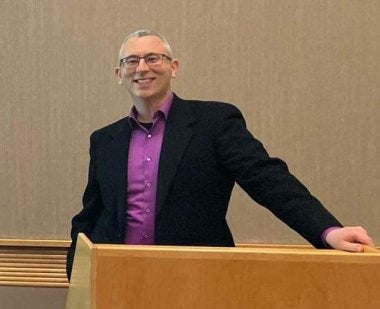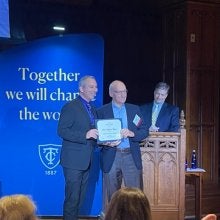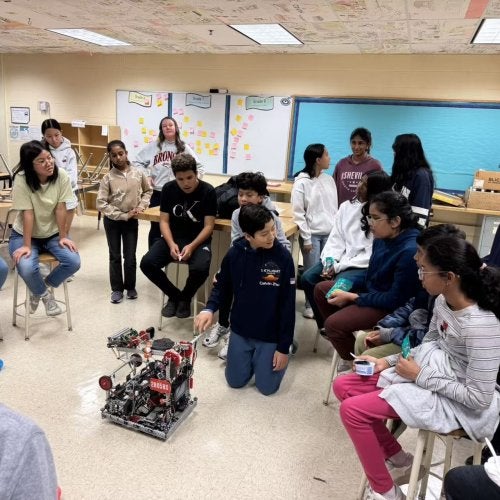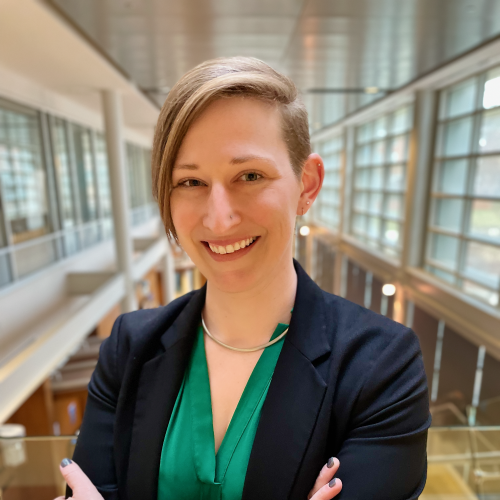
Drew S. Fagan, associate clinical professor and Teaching English to Speakers of Other Languages (TESOL) program coordinator, was recently honored with the 2023 Distinguished Alumni-Early Career Award from Teachers College, Columbia University, for his work with multilingual learners, their educators and policymakers around the state of Maryland and beyond.
Fagan is immediate past president of the Maryland TESOL Association and has helped shape statewide policy through his work on the Blueprint for Maryland’s Future: Workgroup on English Learners in Public Schools and the External Stakeholders Committee for the Every Student Succeeds Act Maryland State Plan.
This award is the latest in a series of honors Fagan has received throughout his career, including 2023 TESOL Teacher of the Year, the top teaching honor in the international TESOL field.
Fagan discusses his career in TESOL and emerging challenges facing the field, as well as important things all educators should know in order to support multilingual learners.

What originally drew you to the TESOL field?
I always had a passion for learning languages and about different cultures. This started with my Italian great-grandmother, who hardly spoke any English. I loved her Italian sounds, the length with which she spoke and even her English errors! My school didn’t offer Italian, so I started taking Spanish as soon as I could (it being the closest language to Italian).
In college, I double majored in Spanish and international relations at American University and studied abroad in Madrid, Spain. I wanted to teach Spanish abroad after I graduated, but at the time, going abroad to teach languages was mostly limited to teaching your “native language.” I ended up teaching English in Tokyo. I thought teaching English would be a breeze since it was my dominant language, but I quickly learned that wasn’t the case. I also learned how varied English is around the world. I was hooked on delving into it even further. I knew then that my career would be TESOL, though I didn’t know the term at the time.
What has been the most rewarding aspect of your career in TESOL?
TESOL is one of the few fields in education which, from its inception, has set out to ensure equitable access to (language) learning for everyone. I have been fortunate to learn so much about how different populations of people experience life. It has made me better reflect on what it means to be a culturally responsive educator, who I am as an individual and how my own identity intersects with my teaching. As a white, cisgender, American English-speaking-dominant male, this was eye-opening.
In the TESOL field, we are more than language specialists. We may be counselors, content co-teachers, interlingual administrative assistants, peer educators and community liaisons, to name a few roles. We need to be cognizant of working with different populations of students, families, colleagues and communities and understand that everyone brings their own knowledge and ways of approaching teaching and learning to the table. Just having this understanding at the outset can lead to more equitable education opportunities for different populations of people. General education has moved in that direction quite quickly in recent years. However, this is something that the TESOL field has been doing for decades.
What do non-ESOL-specialist educators need to know to support multilingual learners?
All educators should have knowledge of the second language acquisition process. It’s equally important to understand what components of the English language–including vocabulary, grammar and structure–multilingual learners need to have to achieve a content objective, such as writing a science lab report.
Having foundational knowledge of intercultural communication and cross-cultural differences is also essential. My research focuses on how teachers’ interactions promote or hinder language and content learning opportunities in classroom settings. For example, multilingual learners may struggle with group work interactions because the notion of “group work” is a very American concept. Some of our more recent arrivals to the United States come from cultures where the roles of teachers and students are strictly set: teachers lecture, students talk only when called upon.
It’s also important to understand that when we use the terms “multilingual learners of English” or “English learners,” they are actually umbrella terms for varied student populations. Some of these learners are recent arrivals to the United States who come into our classes at grade level in their home language and can draw from those experiences as they work with academic content and English language learning. They tend to be the fastest to exit out of ESOL (English for Speakers of Other Languages) services. Another group of recent arrivals, which has been growing exponentially, are known as SLIFEs (students with limited or interrupted formal education). These students do not have extensive academic knowledge or literacy in their home language to draw from as they acquire English as an additional language but can utilize other components of their lived experiences (like oral language skills or work experience) to help them with English. Yet another group are students who have been in the American educational system for at least six years but continue to struggle with components of reading and writing in academic settings. Depending on the school, all of these students could be put in the same class because they fall under the “multilingual learner” or “English learner” labels. Differentiation is key in this case!
What are some of the biggest challenges facing multilingual learners and their educators today?
First, the COVID-19 pandemic shed a light on the already existing inequities that culturally and linguistically diverse learners face in the American educational system. What comes to mind is lack of access to technology for many of our multilingual populations, particularly our newer arrivals. The pandemic also highlighted the importance for revamping teacher education to focus more on how to address the needs of multilingual learners remotely. It was an immense struggle, considering that a lot of language learning connects to real-time verbal and non-verbal interactions, which can get lost in virtual settings. More research is beginning to surface on how to address this newish conundrum.
Second, we now have more student populations from cultures and countries that were not historically largely represented among Maryland’s multilingual learner population (e.g., students from Afghanistan and Ukraine). It takes time for educators to grasp what these new populations bring to the classroom and what their specific needs are.
Third, ESOL educators are increasingly becoming de facto professional development facilitators for their non-ESOL colleagues, all of whom must contend with addressing multilingual learners’ needs across the curriculum. Many ESOL educators are now requesting more professional development for themselves to learn how to be teacher educators for their peers and administrators.
Finally, non-ESOL educators are also looking for professional development to help them support their multilingual learners. UMD’s Ed.D. in School System Leadership-Specialization in TESOL and Dual Language Education, which I developed and currently direct, provides administrators with tools to address the needs of culturally and linguistically diverse learners at the school- and district-levels and to provide much needed support for teachers.


